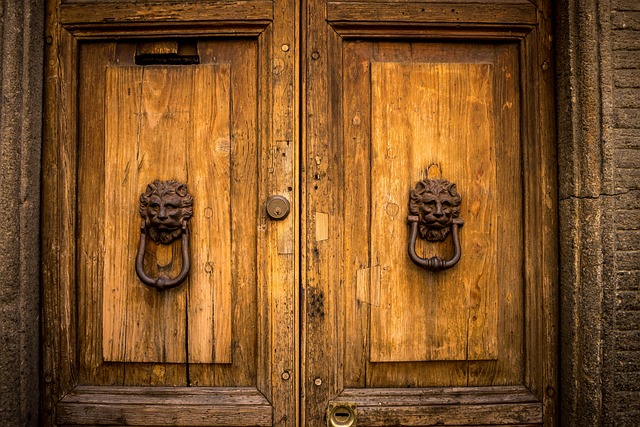Door closers and automatic openers are essential components of door maintenance services, enhancing security, accessibility, and energy efficiency in both commercial and residential settings. They ensure secure closures, minimize drafts, and streamline entry/exit, particularly in high-traffic areas. Different types of door closers and openers cater to various needs, with installation guided by simple steps for DIY or professional door maintenance services. Key factors for selection include door weight, environmental conditions, traffic volume, nearby obstacles, and regular maintenance.
Enhance your door maintenance services with the installation of door closers and automatic openers. This comprehensive guide explores their vital role in ensuring smooth, efficient, and secure door functionality. We delve into the benefits, types, and process of integration, empowering you to choose the optimal solutions for various applications. From understanding the basics to selecting the right hardware, this article provides essential insights for professionals aiming to revolutionize their door maintenance practices.
Understanding Door Closers and Automatic Openers: Their Role in Door Maintenance Services
Door closers and automatic openers play a pivotal role in enhancing door functionality within various settings, from commercial buildings to residential homes. These devices are not just about convenience; they are essential components of door maintenance services. Door closers ensure that doors close securely, preventing drafts and potential security risks. They also contribute to energy efficiency by minimizing heat loss through gaps left by improperly closed doors.
Automatic openers, on the other hand, offer accessibility benefits for people with physical limitations or when hands are full. They are particularly valuable in public spaces, improving user experience and compliance with accessibility standards. In essence, integrating door closers and automatic openers as part of door maintenance services not only improves convenience and security but also contributes to a well-maintained, welcoming, and accessible environment for all occupants.
Benefits of Installing Door Closers for Functionality and Efficiency
Installing door closers offers a multitude of benefits for both residential and commercial properties, significantly enhancing functionality and efficiency in door management. These devices ensure doors close smoothly and securely, preventing unwanted entry or exit and maintaining optimal indoor conditions. Door closers are particularly useful in public spaces, where crowd control and access management are crucial, ensuring doors remain closed during peak hours or special events to prevent congestion and enhance safety.
Moreover, regular use of door closers contributes to effective door maintenance services by reducing wear and tear on hinges and door frames, thus prolonging the lifespan of doors. They also play a vital role in energy conservation by minimizing drafts and preventing heat loss or gain, depending on the climate. This not only leads to cost savings on heating and cooling bills but also aligns with sustainability goals for green building practices.
Types of Door Closers and Their Applications: A Comprehensive Overview
Door closers and automatic openers play a pivotal role in enhancing door functionality, safety, and convenience. The variety of options available caters to diverse needs, from heavy commercial doors to light residential ones. Among the most common types are floor-mounted closer systems, ideal for interior doors requiring precise control. Surface-mounted models offer flexibility, making them suitable for various applications, including exterior doors that face harsh weather conditions.
For high-traffic areas, automatic openers are a game-changer, ensuring swift and hands-free entry/exit. These devices are particularly valuable in public spaces like schools, offices, and shopping malls, where door maintenance services are crucial for upkeep and security. Additionally, sensitive environments like hospitals and care facilities benefit from accessibility features that these automatic systems provide, contributing to a seamless flow of people while maintaining hygiene standards.
The Process of Integrating Automatic Openers: Step-by-Step Guide
Integrating automatic openers into your door system is a straightforward process, enhancing both accessibility and security. Here’s a step-by-step guide for installation:
1. Preparation: Begin by ensuring your door is clean and clear of obstructions. Remove any hardware that might interfere with the opener’s mounting. Gather all necessary tools, including screws, brackets, and the automatic opener mechanism.
2. Mounting the Opener: Identify the optimal location for the opener, usually on the door frame or wall nearby. Secure the mounting brackets in place using the provided hardware. Attach the electric motor of the automatic opener to the bracket, ensuring it’s firm and level. Connect the control unit, which often includes a sensor, allowing the door to detect obstacles and trigger opening/closing.
Choosing the Right Door Closer or Opener: Factors to Consider for Optimal Performance
When selecting a door closer or automatic opener, several key factors come into play for optimal performance and longevity. First, consider the door’s weight and size, as these determine the necessary force and speed required for smooth operation. Heavier doors may need more robust hardware to prevent sag and ensure proper alignment.
The environment is another critical consideration for door maintenance services. Factors like weather exposure, traffic volume, and nearby obstacles can impact functionality. For exterior doors, choose models that withstand harsh conditions, while high-traffic areas might necessitate openers with advanced sensors for precise control. Regular maintenance, such as lubricating hinges and adjusting mechanisms, also plays a vital role in keeping these devices in top shape.
In conclusion, investing in door closers and automatic openers is a strategic move for enhancing door maintenance services. These devices offer significant functionality benefits, ensuring doors operate smoothly and efficiently. By understanding the different types of door closers, their applications, and choosing the right components, professionals can elevate the quality of their door maintenance services, catering to modern building requirements.
